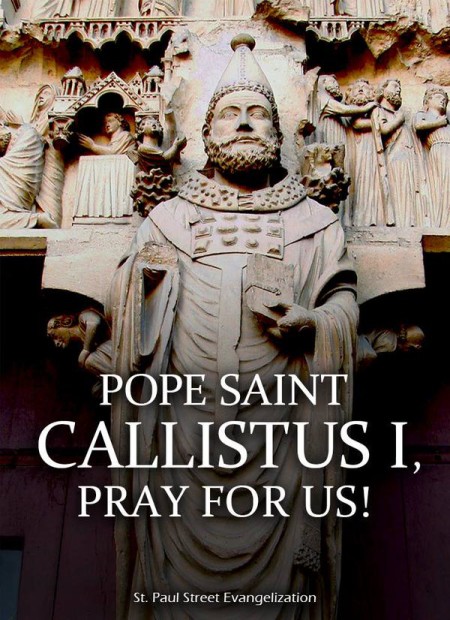 Pope Saint Callistus I
Pope Saint Callistus I
Image Courtesy: St. Paul Street Evangelization
(Franciscan Media) The most reliable information about today’s Saint, Pope Callistus I that we have to rely upon comes from his one time enemy Saint Hippolytus (Feast Day: 13 August) an early Antipope, who later was reconciled with the Church and Martyred for Christ.
Callistus was born a slave according to SQPN owned by Carpophorus a Christian in the household of Caesar. — Callistus was put in charge of the bank of his Master which took in several deposits, he had made several loans to people that refused to pay back their loans and the bank went broke. Knowing that he would be blamed and punished, Callistus fled but was subsequently caught and returned to Carpophorus. Several depositors begged for Callistus’ life believing that he had not lost thew money but just hid it–they were wrong. Callistus was not a thief, just a victim but nevertheless, he was sentenced to work in the Tin Mines.
By a quirk of Roman Law, the ownership of Callistus was transferred from Carpophorus to the State and when he was subsequently ransomed out of his sentence with a number of other Christians he became a Free man, later residing in Anzio, which was the site of the famous WW II beachhead.
After Callistus was Freed from slavery, he was made Superintendent of the public Christian burial grounds in Rome (to this day its still called the Cemetery of St. Callistus) probably the first land owned by the Church.
Pope Zephrinus Ordained Callistus a Deacon, together with making him his friend and advisor. — Callistus was subsequently elected Pope by a majority vote of the Clergy and Laity of Rome.
During his Papacy, Pope Callistus I was on more than one occasion accused of heresy by St. Hippolytus for such actions such as permitting a return to Communion for those who had sinned, repented and done penance or for declaring that differences in economic class were no barrier to marriage. This last, put in him conflict with Roman Civil Law but Pope Callistus argued that in matters concerning the Church and the Sacraments, Church Law trumped Civil Law.
In both cases, Pope Callistus taught what the Church has taught for centuries, including today and though a whole host of Schismatics wrote against him, his alleged crimes appear to have been the practice of Christianity — Pope Callistus was subsequently Martyred for Christ during the persecutions of Roman Emperor Alexander Severus (222-235) and is the first Pope (except for St. Peter) to be commemorated as a Martyr of the Church.
Tweet